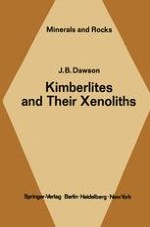
1980 | OriginalPaper | Buchkapitel
Petrography of Kimberlite
verfasst von : Professor J. Barry Dawson
Erschienen in: Kimberlites and Their Xenoliths
Verlag: Springer Berlin Heidelberg
Aktivieren Sie unsere intelligente Suche, um passende Fachinhalte oder Patente zu finden.
Wählen Sie Textabschnitte aus um mit Künstlicher Intelligenz passenden Patente zu finden. powered by
Markieren Sie Textabschnitte, um KI-gestützt weitere passende Inhalte zu finden. powered by
Kimberlite is a petrographically complex, hybrid rock, since it contains not only the phases crystallizing from the liquid magma but also polycrystalline fragments or single crystals derived from various types of fragmented xenolith. It is appropriate here to refer the reader to Chapter 7 where the xenolith-derived minerals are described. One of the main characteristics of kimberlite is the inequigranular texture, due to included xenoliths and megacrysts of various minerals set within a finer-grained matrix containing microphenocrysts. The term megacryst is used here deliberately to avoid any genetic connotation since detailed mineralogical studies of kimberlite have shown that these larger crystals consist of both xenocrysts and high-pressure phenocrysts. The commoner megacrysts, that may exceptionally be up to 15 cm in size (though 0.5–3 cm is much more common), are olivine (or serpentine), picro-ilmenite, mica, pyroxene and garnet; these are set in a matrix of serpentine-group minerals and carbonate, containing microphenocrysts of mica, spinel, perovskite and rare diopside and monticellite in varying proportions; the matrix may vary from light yellow to dark green or black, depending upon the type and proportion of phases present. Only the commoner phases are mentioned and a more comprehensive list of kimberlite phases is given in the following chapter. Diamond may or may not be present as a rare accessory mineral; although in his original definition of kimberlite, Lewis (1887) specifically included diamond as an essential constituent of kimberlite, Dawson (1967a) proposed that diamond is not essential and thus extended the name to include many so-called mica-peridotites that in every other respect (mode of occurrence, tectonic setting, mineralogy, petrography and geochemistry) resemble kimberlite.